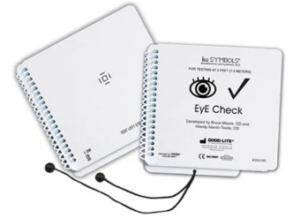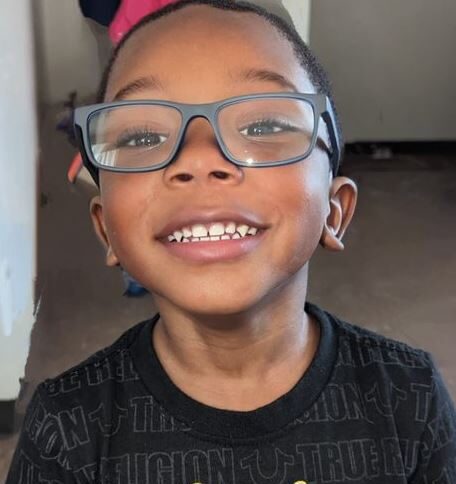Children’s Vision Ages 3-5
Approximately 1 in 5 preschool-age children in the U.S., including preschool-age Head Start children, has a vision disorder that requires monitoring and/or treatment by an eye doctor and 1 in 4 school-aged children has a vision problem.
The time during a child’s 3rd to 5th birthday is the critical period of development for their vision. It is important that a child receives a vision screening each year to determine if they are at risk for a vision problem.
Why is Vision Important?
If vision conditions are not detected and treated early, these outcomes could occur:
- Permanent vision loss
- Reduced ability to learn
- Poor athletic performance
- Loss of self-esteem
What is a Children’s Vision Screening?
A vision screening is not an eye exam. A vision screening identifies children who are at high risk for a vision problem and alerts parents and caregivers that a complete, dilated eye exam is recommended.
How do we Complete a Children’s Vision Screening?
- Chart screening: Each child plays a “picture game” in which they are asked to identify a series of 4 pictures (square, house, apple, circle) at a 5-foot distance. Each eye is vision screened individually. If the child does not identify a minimum of 3 out of the 4 pictures correctly in either eye, it is recommended they receive a dilated eye exam from an eye doctor.
- Instrument-based screening: The child is vision screened with an instrument-based screening tool. These devices resemble a camera and checks the eye for any possible vision concerns or risk factors. These tools are approved in Prevent Blindness Wisconsin vision screening protocol for children in 3K, 4K, and Kindergarten. If the instrument-based screening tool detects a possible problem, it is recommended the child receives a dilated eye exam from an eye doctor.

Common Vision Conditions
A refractive error is a defect in the optics of the eye that results in lack of precise focus of the light rays on the retina causing a blurred image.
Hyperopia: (hi-per-OH-pea-uh), Or farsightedness, is a type of refractive error. Hyperopia is a vision condition in which near objects appear blurred – such as books or toys- but objects in the distance remain clear. Children with severe farsightedness may also experience crossed eyes, eyestrain, and a reduced quality of life.
Hyperopia Treatment: Some children will require glasses to help correct their hyperopia. Other children may outgrow their need for glasses as they get older. Your ophthalmologist or optometrist will work with you to identify the right treatment plan for your child.
Myopia: Or nearsightedness, is a type of refractive error. Myopia occurs when distant objects are blurred, while objects up close are seen with more clarity.
Myopia Treatment: Some children will require glasses to help correct their myopia. The best preventative practice includes limiting screen time and getting outside each day. Your ophthalmologist or optometrist will work with you to identify the right treatment plan for your child.
Astigmatism: Astigmatism occurs because there is an irregular curvature of the cornea preventing light rays from focusing on a single point on the retina.
Astigmatism Treatment: Children will often need glasses to help correct their astigmatism. Your ophthalmologist or optometrist will work with you to identify the right treatment plan for your child.
Strabismus: Strabismus is a word for eyes that are not straight or do not line up with each other. If the problem is not treated, it can cause amblyopia (or lazy eye).
The misalignment results from the failure of the eye muscles to work together. One eye, or sometimes both, may turn in (crossed eyes), turn out (wall eyes), turn up or turn down. Sometimes more than one of the ‘turns’ are present.
Strabismus Treatment:
Strabismus cannot be outgrown, nor will it improve by itself. Treatment to straighten the eyes is required. The types of treatments may be used alone or in combination, depending on the type of strabismus and its cause.
- Glasses are commonly prescribed to improve focusing and redirect the line of sight, enabling the eyes to straighten.
- Medication in the form of eye drops or ointment may be used, with or without glasses. Injected medication may be used to selectively weaken an overactive eye muscle.
- Surgery may be performed on eye muscles to straighten the eyes if nonsurgical means are unsuccessful.
- An eye doctor may recommend eye exercises either before or after surgery.
Amblyopia: Is reduced vision in an eye that has not received adequate use during early childhood.
Causes: Most often amblyopia results from either a misalignment of a child’s eyes, such as crossed eyes, or a difference in image quality between the two eyes (one eye focusing better than the other.)
In both cases, one eye becomes stronger, causing the other eye to become weaker. If this condition persists, the weaker eye may suffer permanent vision loss.
Treatment: It is best to treat Amblyopia as soon as possible for best outcomes.
Treatment plans will be determined by an eye care professional and can range from glasses, patching, medication, or surgery.
Kid’s Take it Outside
According to the American Academy of Pediatric Ophthalmology and Strabismus (AAPOS), children ages 2-5 should be limited to one hour of screen time a day.
To read the full article from the AAPOS click here.
For tips and tricks to limit screen time and the importance of getting kids outside, follow the link to our Kids Take it Outside page.
